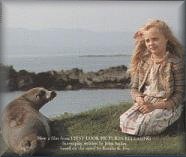|
|
|

|
|
|
It is possible that these old folk beliefs are the remnants of our ancient racial memory, from a  time when Mankind had much stronger empathy with animals. Perhaps we were
able to communicate telepathically with them. As the sea is where all Life
first began, we have a deep, primeval link with the realms of water and
all who dwell in her domain.
time when Mankind had much stronger empathy with animals. Perhaps we were
able to communicate telepathically with them. As the sea is where all Life
first began, we have a deep, primeval link with the realms of water and
all who dwell in her domain.
The islands have numerous legends relating to the selkie-folk. Unlike the Finn-Folk, the selkie-folk are not malicious creatures but rather gentle shapeshifters with the ability to transform from seals into beautiful, lithe humans. There is no agreement as to how often the selkie's can perform this feat - in some tales it is once a year, usually on Midsummer's Eve (referred to as Johnsmas Eve), whereas in others it was "every ninth night" or "every seventh stream". However often they transformed, folklore tells us that once in human form the selkie-folk would often dance merrily on the moonlit seashore or bask on sun drenched rocks.
The male members among the selkie folk were thought to have had many trysts with human females, married and unmarried. A selkie man in human form was a handsome creature with almost magical seductive powers over mortal women. These selkie-men had no qualms in shedding their skins, hiding them carefully, and heading inland, seeking illicit intercourse with an "unsatisfied woman". Selkie men sometimes beget children on mortal women, as in the folk song 'The Selkie of Sule Skerry'. After a period of seven years, the selkie returned to the woman to claim his son, but with tragic consequences. Should any mortal woman wish to make contact with a selkie-man, it was common belief that the woman need simply shed seven tears into the sea at high tide. If the selkie-men were attractive in the eyes
of earth-born women, the selkie females were no Children said to the result of a union between mortal and selkie were relatively common and until fairly recently some Orcadian families still claimed descent from the Selkie Folk. One allegedly true story, documented by the Orcadian folklorist, Walter Traill Dennison, tells how the children of a north isles family were all born with webbed feet and fingers. The mid-wife present at the birth clipped the webs with shears, "and many a clipping Ursilla clipped, to keep the fins from growing again; and the fins, not being able to grow in their natural way, grew into a horny crust on the palms of the hands and soles of the feet. And this horny substance can be seen in many of Ursilla's descendants to this day". Dennison finished by stating "whatever may be thought of this tale, its last sentence is quite true." Often in the Hebrides local people have heard
strange, sorrowful music out at sea that would In the Hebrides it was also believed that certain families were descended from seals. One such family are the MacCodrums of North Uist that Fiona MacLeod refers to in his story 'The Dan nan Ron'. These families were known as the 'sliocha nan ron'. They were believed to be under the enchantment of the seals and to carry the seal blood within. Once such a person had taken on the form of a seal, they could no longer return to live on the dry land. They would be 'dead' to those that knew them before. The mythological origin of the selkie folk is not clear - some said that they were fallen angels who were condemned to become seals while others said that they were once human beings who, for some grave misdemeanour were doomed to assume the seal's form and live out the rest of their days in the sea. "When angels fell, some fell on the land, some on the sea. The former are the faeries and the latter were often said to be the seals." "An' wha kens," said one of Dennison's old gossips, "bit thulll mibbe git lave tae come back tae thur owld state."
Note: If you have an interest in the Selkie
Folk, the book "A Stranger Came Ashore" by Mollie Hunter
|